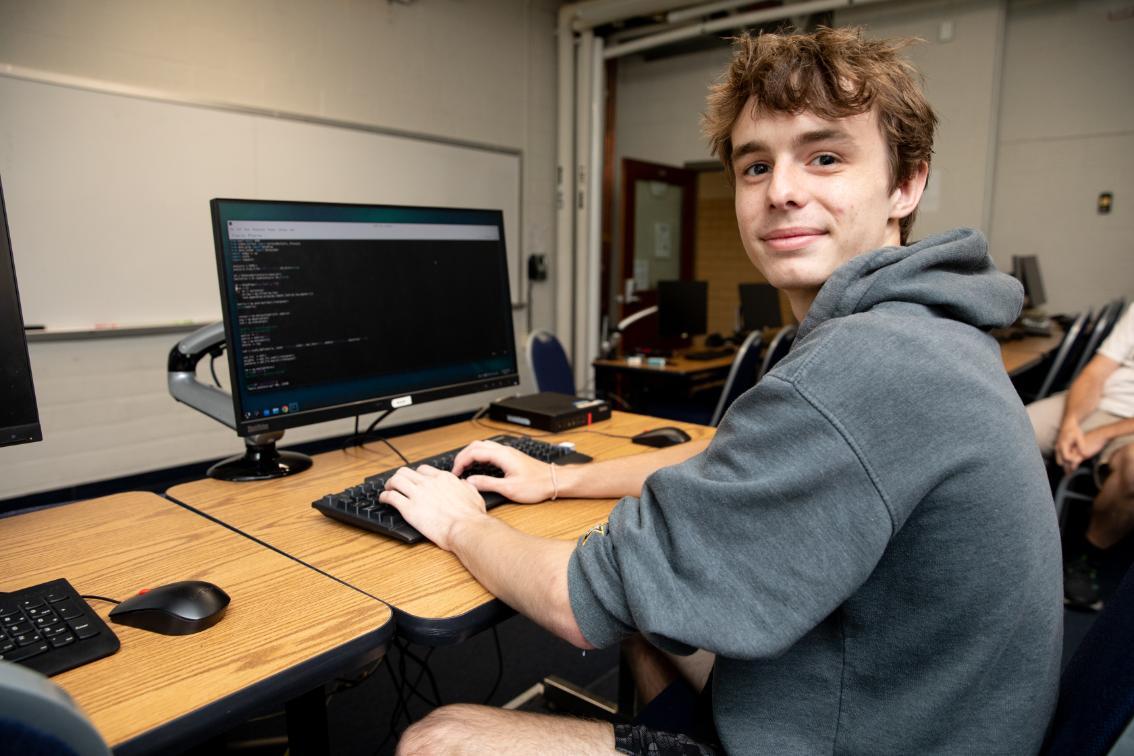

Eli Stark ’26 spent the first half of his summer working with Dr. Julian Dymacek using non-negative matrix factorization, a technique that helps extract useful information from large sets of data, to find patterns in transient bird movement.
Stark is among this year’s participants in PRISM (Perspectives on Research in Science and Mathematics), Longwood’s eight-week summer research program that pairs a faculty member with one or two students to work collaboratively on a project in biology, chemistry, environmental science, mathematics, physics and psychology.
It’s a good opportunity for students to see what academia is beyond just your professor teaching in class. They get to see that there’s this other side of problem solving and looking at research.
Dr. Julian Dymacek, associate professor of computer science
“It’s a good opportunity for students to see what academia is beyond just your professor teaching in class,” said Dymacek, associate professor of computer science. “They get to see that there’s this other side of problem solving and looking at research. It’s a good program.”
We recently caught up with Stark, a computer science major and member of the Cormier Honors College, to learn about his experience as a summer researcher in the PRISM program.
How did you get involved with PRISM?
It was advertised pretty widely in the computer science department. A lot of times in classes we’d hear about why research is a good thing and we’d be encouraged to apply. I also heard about other research programs across the United States. They’re called Research Experiences for Undergraduates (REU), so I had heard a lot about research and decided to apply. I also know somebody who participated last year as well, so that helped out.
Tell us about your project.
We are working on finding patterns of transient bird movement, specifically in Virginia, with swallow-tailed kites right now. Swallow-tailed kites are migratory raptors that come from Central and South America to the coastal regions of the southeastern and southwestern U.S. to breed. Sightings in Virginia are rare. We’re trying to find connections between those sightings and different synoptic weather data, like low pressure systems and high pressure systems. So maybe when there’s a high pressure system here, that brings the swallow-tailed kite up into Virginia. That’s really what we’re looking into. We’re using non-negative matrix factorization to take in the data points we have—the latitudes and longitudes of these pressure systems—and then extract the patterns out from those matrices.
What are some applications of this research?
It’s a great question, because, like, who cares when the swallow-tailed kite shows up? There’s a very small amount of people that it’s affecting in the world. But the system that we’re creating—that takes in data points that are related to time of year or date—can produce a pattern that can predict when things will show up. This can apply to things outside of birds. It can affect anything that has a relation to date and time and a place. Birds are also super related to climate change, so you do see a lot of correlation between those. That’s another reason tracking the birds can be super helpful in the real world.
Doing research has been really fun because I’ve been able to work on a cumulative project over a longer period of time. I really like problem solving, so this is like a bigger problem I get to work on for a longer period of time.
Eli Stark ’26 Tweet This
How do you like your research so far?
Doing research has been really fun because I’ve been able to work on a cumulative project over a longer period of time. I really like problem solving, so this is like a bigger problem I get to work on for a longer period of time. A lot of times in classes it’s not as long term. I get to do a problem for a little bit, but then we move on to the next.
What has been your favorite part of research or the PRISM program so far?
For me, it’s problem solving. I love being challenged and these problems that we’re working on are real-world problems. It feels very rewarding when I’m able to go and solve them and get a real result. In class, I do these things and they’re challenging and they’re hard, and then I get this result out that’s for a grade. And so when I do something that’s real and I’m really producing something that somebody can see and look at and be like, “Wow, something’s showing up here.” It really means something different than just the grade.
What are your plans after graduation?
Before I did this I was really confident I wanted to go right into the computer science industry. My plan was to get out—I’m graduating a year early—and start working as soon as possible. But this has been a lot of fun, and I now realize that grad school is a reasonable option following college. That has been something that’s been put on my radar since I started this project. I don't have any concrete plans right now, but I’ll be looking at possibly going to graduate school or going to work in the industry.
Would you recommend PRISM to other students?
Yes, absolutely. I think it’s a wonderful experience for students to have and is very beneficial. Number one is the connection to a professor. That’s a huge thing. That’s sometimes hard to get in classes, even though we are a smaller school. If you are in a class with 20 to 30 people, you’re not always getting that one-on-one time with a professor that you can get while doing a research project over the summer. So just developing that connection with a professor is super huge. I will say that PRISM isn’t for everyone. But if you enjoy your field and you enjoy looking into new problems, it’s a really good thing for you to do. It’s very enjoyable.
